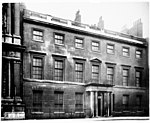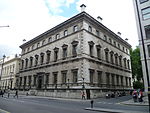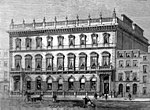King George VI and Queen Elizabeth Memorial
1955 sculptures2009 establishments in England2009 sculpturesBronze sculptures in the United KingdomBuildings and structures on The Mall, London ... and 10 more
George VIGrade II listed statues in the City of WestminsterMonuments and memorials in LondonMonuments and memorials to Queen Elizabeth The Queen MotherOutdoor sculptures in LondonSculptures by Philip JacksonSculptures of men in the United KingdomSculptures of women in the United KingdomStatues of monarchsUse British English from November 2014

The King George VI and Queen Elizabeth Memorial, situated between The Mall and Carlton Gardens in central London, is a memorial to King George VI and his consort, Queen Elizabeth. Completed in its present form in 2009, the memorial incorporates an earlier, Grade II listed statue of George VI by William McMillan, unveiled by his daughter Queen Elizabeth II in 1955. The reconfigured memorial, which includes a statue of the Queen Mother by Philip Jackson, relief sculpture by Paul Day and an architectural setting by Donald Buttress and Donald Insall, was unveiled by Elizabeth II in 2009.
Excerpt from the Wikipedia article King George VI and Queen Elizabeth Memorial (License: CC BY-SA 3.0, Authors, Images).King George VI and Queen Elizabeth Memorial
Carlton Gardens, City of Westminster Victoria
Geographical coordinates (GPS) Address Nearby Places Show on map
Geographical coordinates (GPS)
| Latitude | Longitude |
|---|---|
| N 51.50514 ° | E -0.13373 ° |
Address
Queen Elizabeth (The Queen Mother)
Carlton Gardens
SW1Y 5AA City of Westminster, Victoria
England, United Kingdom
Open on Google Maps









